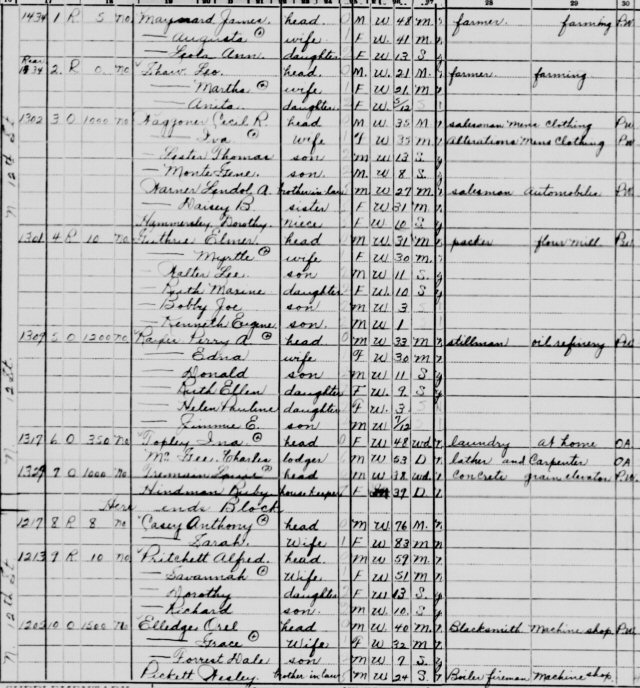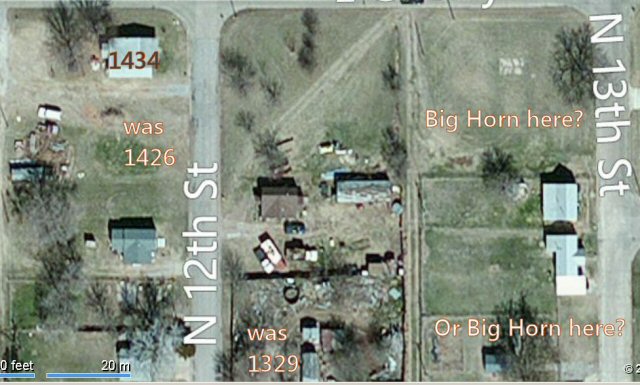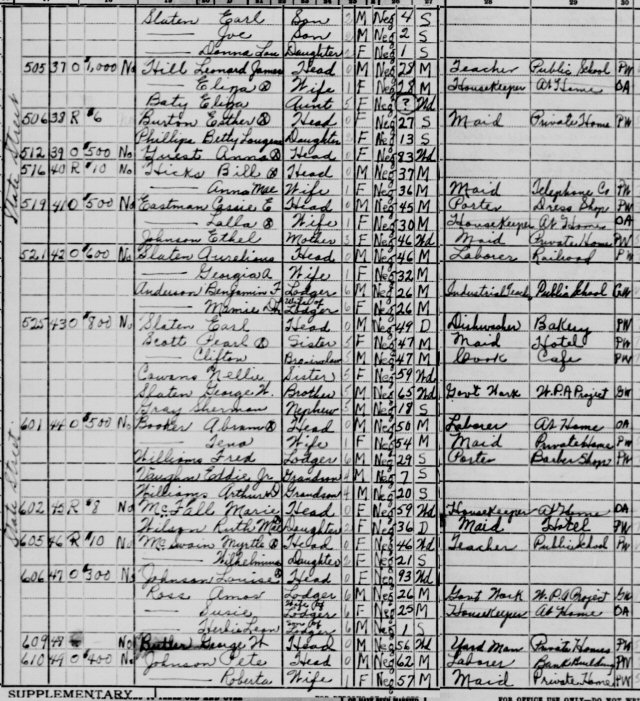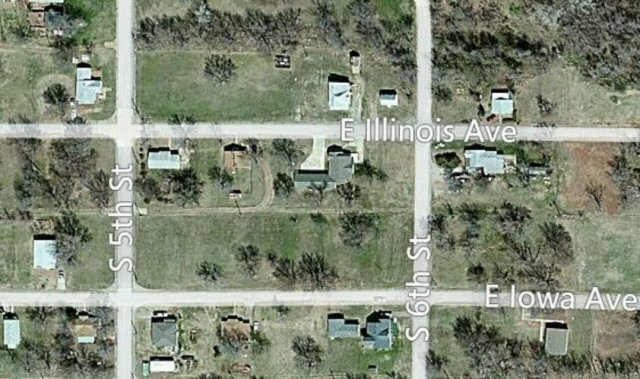Monday, January 13, 2014
Class had a different meaning
A brief follow-up on my 'digital reconstruction' of the mysterious Big Horn in Enid.
Tried to find the Big Horn in the 1940 Census. Unsurprisingly no luck; the census lists only residences. I thought the nearest house might show up, because the occupant of that house in 1972 was also the owner of Big Horn. Possibly my memory of seeing a ref to Big Horn in a 1938 city directory is misdated.
Here's a 1940 census page for those blocks:
 Pretty much the same as '72 in class and density. White working class, mainly working at Champlin or the elevators. Note that 1329 has a live-in housekeeper!
1329 is gone now, subsumed by the same junkyard that covers part of the Big Horn property. 1434, the north end of the block and the northernmost house in Enid at this longitude, seems to have been a big place in 1940. It was absent in 1972 and present again now. I lived in a rental house at 1426, which was absent in 1940, present in 1972, and absent again now. The boom-bust ratchet in action! (Assisted by the 1966 tornado, which sliced through these blocks.)
Pretty much the same as '72 in class and density. White working class, mainly working at Champlin or the elevators. Note that 1329 has a live-in housekeeper!
1329 is gone now, subsumed by the same junkyard that covers part of the Big Horn property. 1434, the north end of the block and the northernmost house in Enid at this longitude, seems to have been a big place in 1940. It was absent in 1972 and present again now. I lived in a rental house at 1426, which was absent in 1940, present in 1972, and absent again now. The boom-bust ratchet in action! (Assisted by the 1966 tornado, which sliced through these blocks.)
 = = = = =
Just for fun, I decided to compare with another currently emptied-out part of Enid, the former black part of town.
Here's a 1940 census page from East State Avenue.
= = = = =
Just for fun, I decided to compare with another currently emptied-out part of Enid, the former black part of town.
Here's a 1940 census page from East State Avenue.
 This page is typical of the area.
First: You can't tell the race by the names. There are no black names or white names. Only correctly spelled English names, written in a heartbreakingly beautiful Palmer cursive. In a modern list you could tell the color instantly and certainly by the Brytneis and Taelyrs and Nevaehs in the white list and the Qunaishas and LaShrandas and TyQuandios in the black list.
Second: Everyone has a job. Women are maids, men are mostly porters (black laborers) or WPA workers. This was typical until Comrade LBJ ripped black neighborhoods apart to create his private welfare army, replacing work by guaranteed welfare.
Third: Notice three schoolteachers on this one page. This was also typical. Every block in the colored area had at least one teacher or preacher or doctor. Working-class white areas had no professionals at all. In other words, a porter had more daily contact with educated people than a laborer did.
Fourth: On these two pages, blacks owned 2/3 of their homes, while whites owned about 1/2. This isn't quite typical; a quick scan through other pages in both zones shows white working-class and blacks about equal at 60%. Hmmmmm. Haven't we always heard that blacks weren't allowed to own homes?
What the area looks like now... In this case the boom-bust ratchet was assisted by the 1973 flood.
This page is typical of the area.
First: You can't tell the race by the names. There are no black names or white names. Only correctly spelled English names, written in a heartbreakingly beautiful Palmer cursive. In a modern list you could tell the color instantly and certainly by the Brytneis and Taelyrs and Nevaehs in the white list and the Qunaishas and LaShrandas and TyQuandios in the black list.
Second: Everyone has a job. Women are maids, men are mostly porters (black laborers) or WPA workers. This was typical until Comrade LBJ ripped black neighborhoods apart to create his private welfare army, replacing work by guaranteed welfare.
Third: Notice three schoolteachers on this one page. This was also typical. Every block in the colored area had at least one teacher or preacher or doctor. Working-class white areas had no professionals at all. In other words, a porter had more daily contact with educated people than a laborer did.
Fourth: On these two pages, blacks owned 2/3 of their homes, while whites owned about 1/2. This isn't quite typical; a quick scan through other pages in both zones shows white working-class and blacks about equal at 60%. Hmmmmm. Haven't we always heard that blacks weren't allowed to own homes?
What the area looks like now... In this case the boom-bust ratchet was assisted by the 1973 flood.
 Sidenote of total puzzlement: Every time I look at the 1930s Depression in a 'close-to-home' context, focusing on places and people and numbers that I know something about, I find a lot less trouble and poverty and drought than we've been led to believe. We have lots of photographic and numerical evidence that the decade was a terrible time for some people and places. Obviously there was a there there. But when I try to pin down the there, it always turns out to be a small and slippery there. My ancestors were right in the middle of the Dust Bowl, and they got through it by scrimping and saving and gov't work. These working-class Enid folks, black and white, kept their homes. Probably the same way my ancestors did.
= = = = =
Update 1/18/14: I just took a magnified look at the name on 1329 N. 12th. I hadn't focused on it before. Bingo! He still lived there in 1972. I remember the name from the mailbox. He was about 70, which fits... and I'm fairly sure he was the owner of the Big Horn. (I don't remember if I picked up the connection from direct conversation or from 2nd-hand hearsay.) So there's part of the mystery solved, but I still don't know whether the place ever operated as a business.
Sidenote of total puzzlement: Every time I look at the 1930s Depression in a 'close-to-home' context, focusing on places and people and numbers that I know something about, I find a lot less trouble and poverty and drought than we've been led to believe. We have lots of photographic and numerical evidence that the decade was a terrible time for some people and places. Obviously there was a there there. But when I try to pin down the there, it always turns out to be a small and slippery there. My ancestors were right in the middle of the Dust Bowl, and they got through it by scrimping and saving and gov't work. These working-class Enid folks, black and white, kept their homes. Probably the same way my ancestors did.
= = = = =
Update 1/18/14: I just took a magnified look at the name on 1329 N. 12th. I hadn't focused on it before. Bingo! He still lived there in 1972. I remember the name from the mailbox. He was about 70, which fits... and I'm fairly sure he was the owner of the Big Horn. (I don't remember if I picked up the connection from direct conversation or from 2nd-hand hearsay.) So there's part of the mystery solved, but I still don't know whether the place ever operated as a business.
 Pretty much the same as '72 in class and density. White working class, mainly working at Champlin or the elevators. Note that 1329 has a live-in housekeeper!
1329 is gone now, subsumed by the same junkyard that covers part of the Big Horn property. 1434, the north end of the block and the northernmost house in Enid at this longitude, seems to have been a big place in 1940. It was absent in 1972 and present again now. I lived in a rental house at 1426, which was absent in 1940, present in 1972, and absent again now. The boom-bust ratchet in action! (Assisted by the 1966 tornado, which sliced through these blocks.)
Pretty much the same as '72 in class and density. White working class, mainly working at Champlin or the elevators. Note that 1329 has a live-in housekeeper!
1329 is gone now, subsumed by the same junkyard that covers part of the Big Horn property. 1434, the north end of the block and the northernmost house in Enid at this longitude, seems to have been a big place in 1940. It was absent in 1972 and present again now. I lived in a rental house at 1426, which was absent in 1940, present in 1972, and absent again now. The boom-bust ratchet in action! (Assisted by the 1966 tornado, which sliced through these blocks.)
 = = = = =
Just for fun, I decided to compare with another currently emptied-out part of Enid, the former black part of town.
Here's a 1940 census page from East State Avenue.
= = = = =
Just for fun, I decided to compare with another currently emptied-out part of Enid, the former black part of town.
Here's a 1940 census page from East State Avenue.
 This page is typical of the area.
First: You can't tell the race by the names. There are no black names or white names. Only correctly spelled English names, written in a heartbreakingly beautiful Palmer cursive. In a modern list you could tell the color instantly and certainly by the Brytneis and Taelyrs and Nevaehs in the white list and the Qunaishas and LaShrandas and TyQuandios in the black list.
Second: Everyone has a job. Women are maids, men are mostly porters (black laborers) or WPA workers. This was typical until Comrade LBJ ripped black neighborhoods apart to create his private welfare army, replacing work by guaranteed welfare.
Third: Notice three schoolteachers on this one page. This was also typical. Every block in the colored area had at least one teacher or preacher or doctor. Working-class white areas had no professionals at all. In other words, a porter had more daily contact with educated people than a laborer did.
Fourth: On these two pages, blacks owned 2/3 of their homes, while whites owned about 1/2. This isn't quite typical; a quick scan through other pages in both zones shows white working-class and blacks about equal at 60%. Hmmmmm. Haven't we always heard that blacks weren't allowed to own homes?
What the area looks like now... In this case the boom-bust ratchet was assisted by the 1973 flood.
This page is typical of the area.
First: You can't tell the race by the names. There are no black names or white names. Only correctly spelled English names, written in a heartbreakingly beautiful Palmer cursive. In a modern list you could tell the color instantly and certainly by the Brytneis and Taelyrs and Nevaehs in the white list and the Qunaishas and LaShrandas and TyQuandios in the black list.
Second: Everyone has a job. Women are maids, men are mostly porters (black laborers) or WPA workers. This was typical until Comrade LBJ ripped black neighborhoods apart to create his private welfare army, replacing work by guaranteed welfare.
Third: Notice three schoolteachers on this one page. This was also typical. Every block in the colored area had at least one teacher or preacher or doctor. Working-class white areas had no professionals at all. In other words, a porter had more daily contact with educated people than a laborer did.
Fourth: On these two pages, blacks owned 2/3 of their homes, while whites owned about 1/2. This isn't quite typical; a quick scan through other pages in both zones shows white working-class and blacks about equal at 60%. Hmmmmm. Haven't we always heard that blacks weren't allowed to own homes?
What the area looks like now... In this case the boom-bust ratchet was assisted by the 1973 flood.
 Sidenote of total puzzlement: Every time I look at the 1930s Depression in a 'close-to-home' context, focusing on places and people and numbers that I know something about, I find a lot less trouble and poverty and drought than we've been led to believe. We have lots of photographic and numerical evidence that the decade was a terrible time for some people and places. Obviously there was a there there. But when I try to pin down the there, it always turns out to be a small and slippery there. My ancestors were right in the middle of the Dust Bowl, and they got through it by scrimping and saving and gov't work. These working-class Enid folks, black and white, kept their homes. Probably the same way my ancestors did.
= = = = =
Update 1/18/14: I just took a magnified look at the name on 1329 N. 12th. I hadn't focused on it before. Bingo! He still lived there in 1972. I remember the name from the mailbox. He was about 70, which fits... and I'm fairly sure he was the owner of the Big Horn. (I don't remember if I picked up the connection from direct conversation or from 2nd-hand hearsay.) So there's part of the mystery solved, but I still don't know whether the place ever operated as a business.
Sidenote of total puzzlement: Every time I look at the 1930s Depression in a 'close-to-home' context, focusing on places and people and numbers that I know something about, I find a lot less trouble and poverty and drought than we've been led to believe. We have lots of photographic and numerical evidence that the decade was a terrible time for some people and places. Obviously there was a there there. But when I try to pin down the there, it always turns out to be a small and slippery there. My ancestors were right in the middle of the Dust Bowl, and they got through it by scrimping and saving and gov't work. These working-class Enid folks, black and white, kept their homes. Probably the same way my ancestors did.
= = = = =
Update 1/18/14: I just took a magnified look at the name on 1329 N. 12th. I hadn't focused on it before. Bingo! He still lived there in 1972. I remember the name from the mailbox. He was about 70, which fits... and I'm fairly sure he was the owner of the Big Horn. (I don't remember if I picked up the connection from direct conversation or from 2nd-hand hearsay.) So there's part of the mystery solved, but I still don't know whether the place ever operated as a business.
